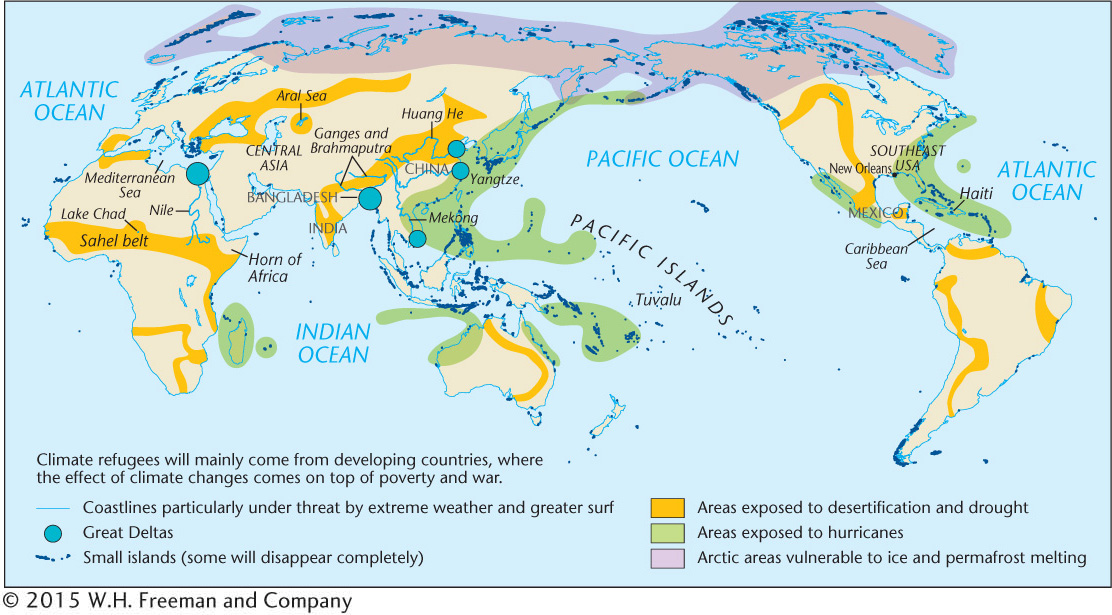NATURE-CULTURE
3.4
LEARNING OBJECTIVE
Recognize the ways in which the natural world shapes population characteristics, and how population characteristics in turn shape the natural world.
The reasons for human populations forming such diverse patterns are often cultural. Though the differences may have started out as adaptations to given physical conditions, when repeated from generation to generation, these patterns become woven tightly into the cultural fabric of places. Thus, demographic practices such as living in crowded settlements or having large families may well have deep roots in both nature and culture.
119
ENVIRONMENTAL INFLUENCE
Local population characteristics are often influenced by the availability of resources. In the middle latitudes, population densities tend to be greatest where the terrain is level, the climate is mild and humid, the soil is fertile, mineral resources are abundant, and the sea is accessible. Conversely, population tends to thin out with excessive elevation, aridity, coldness, ruggedness of terrain, and distance from the coast.
Climatic factors influence where people settle. Most of the sparsely populated zones in the world have, in some respect, difficult climates from the viewpoint of human habitation (see Figure 3.1). The thinly populated northern edges of Eurasia and North America are excessively cold, and the belt of sparse population extending from North Africa into the heart of Eurasia matches the pattern in major desert zones of the Eastern Hemisphere. Humans remain largely creatures of the humid and subhumid tropics, subtropics, or midlatitudes and have not fared well in excessively cold or dry areas. Small populations of Inuit (Eskimo), Sami (Lapps), and other peoples live in some of the less hospitable areas of the Earth, but these regions do not support large populations, while Antarctica is home only to a handful of researchers. Humans have proven remarkably adaptable, and our cultures include strategies that allow us to live in many different physical environments. As a species, however, perhaps we have not entirely moved beyond the adaptive strategies that suited us so well to the climatic features of sub-Saharan Africa, where we began.
adaptive strategies
The unique way in which each culture uses its particular physical environment; those aspects of culture that serve to provide the necessities of life-food, clothing, shelter, and defense.
Humankind’s preference for lower elevations is especially true for the middle and higher latitudes. Most mountain ranges in those latitudes stand out as sparsely populated regions. By contrast, inhabitants of the tropics often prefer to live at higher elevations, concentrating in dense clusters in mountain valleys and basins (see Figure 3.1). For example, in tropical portions of South America, more people live in the Andes Mountains than in the nearby Amazon lowlands. The capital cities of many tropical and subtropical nations lie in mountain areas above 3000 feet (900 meters) in elevation. Living at higher elevations allows residents to escape the hot, humid climate and diseases of the tropic lowlands. In addition, these areas were settled because the fertile volcanic soils of these mountain valleys and basins were able to support larger populations in agrarian societies.
Humans often live near the sea. The continents of Eurasia, Australia, and South America resemble hollow shells, with the majority of the population clustered around the rim of each continent (see Figure 3.1). In Australia, half the total population lives in only five port cities, and most of the remainder is spread out over nearby coastal areas. This preference for living by the sea stems partly from the trade and fishing opportunities the sea offers. At the same time, continental interiors tend to be regions of climatic extremes. For example, Australians speak of the “dead heart” of their continent, an interior land of excessive dryness and heat (Figure 3.24).
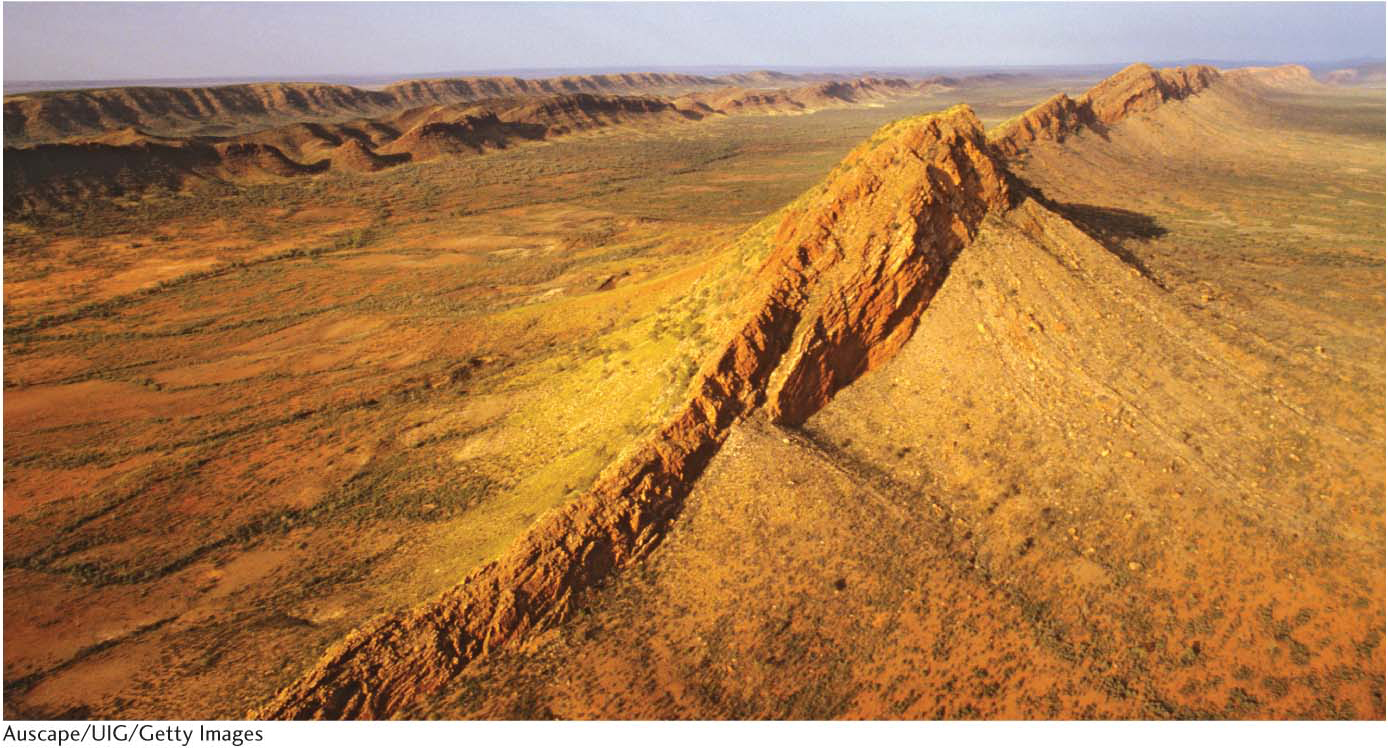
Disease also affects population distribution. Some diseases attack valuable domestic animals, depriving people of food and clothing resources. Such diseases have an indirect effect on population density. For example, in parts of East Africa, a form of sleeping sickness attacks livestock. This particular disease is almost invariably fatal to cattle but not humans. The people in this part of East Africa depend heavily on cattle, which provide food, represent wealth, and serve a religious function in some tribes. The spread of a disease fatal to cattle has caused entire tribes to migrate away from infested areas, leaving those areas unpopulated.
120
ENVIRONMENTAL PERCEPTION, SETTLEMENT, AND MIGRATION
Perception of the physical environment plays a major role in a group’s decision about where to settle and live. Different cultural groups often “see” the same physical environment in different ways. These varied responses to a single environment influence the distribution of people. A good example appears in a part of the European Alps shared by German- and Italian-speaking peoples. The mountain ridges in that area—near the point where Switzerland, Italy, and Austria border one another—run in an east-west direction, so that each ridge has a sunny, south-facing slope and a shady, north-facing one. German-speaking people, who rely on dairy farming, long ago established permanent settlements some 650 feet (200 meters) higher on the shady slopes than the settlements of Italians, who are culturally tied to warmth-loving crops, on the sunny slopes. This example demonstrates how contrasting cultural attitudes toward the physical environment and land use affect settlement patterns.
Sometimes the same cultural group changes its perception of an environment over time, with a resulting redistribution of its population. The coalfields of western Europe provide a good case in point. Before the industrial age, many coal-rich areas—such as the Midlands of England, southern Wales, and the lands between the headwaters of the Oder (or Odra) and Vistula rivers in Poland—were only sparsely or moderately settled. The development of steam-powered engines and the increased use of coal in the iron-smelting process, however, created a tremendous demand. Industries grew up near the European coalfields, and people flocked to these areas to take advantage of the new jobs. In other words, once a technological development gave a new cultural value to coal, many sparsely populated areas containing that resource acquired large concentrations of people.
Recent studies indicate that much of the migration within the United States today is prompted by a desire for a pleasant climate and other desirable physical environmental traits, such as beautiful scenery. Surveys of immigrants to Arizona revealed that its sunny, warm climate is a major reason for migration. An attractive environment provided the dominant factor in the growth of the population and economy of Florida. The most desirable environmental traits that serve as stimulants for American migration include (1) mild winter climate and a mild summer climate with low humidity, (2) mountainous terrain, (3) diverse natural vegetation that includes forests, (4) the presence of lakes and rivers, and (5) nearness to the seacoast. Different age and cultural groups often express different preferences, but all are influenced by their perceptions of the physical environment in making decisions about migration.
POPULATION DENSITY AND ENVIRONMENTAL ALTERATION
People modify their habitats through their adaptive strategies. Particularly in areas where population density is high, radical alterations often occur. This can also happen in fragile environments even at relatively low population densities because, as discussed earlier in this chapter, the Earth’s carrying capacity varies greatly from one place to another and from one culture to another.
Many of our adaptive strategies are not sustainable. Population pressures and local ecological crises are closely related. For example, in Haiti, where rural population pressures have become particularly severe, the trees in previously forested areas have been felled for fuel, leaving the surrounding fields and pastures increasingly denuded and vulnerable to erosion (Figure 3.25). In short, overpopulation relative to resource availability can precipitate environmental destruction—which, in turn, results in a downward cycle of worsening poverty, with an eventual catastrophe that is both ecological and demographic. Thus, many cultural ecologists believe that attempts to restore the balance of nature will not succeed until we halt or even reverse population growth, although they recognize that other causes are also at work in ecological crises (Figure 3.26).
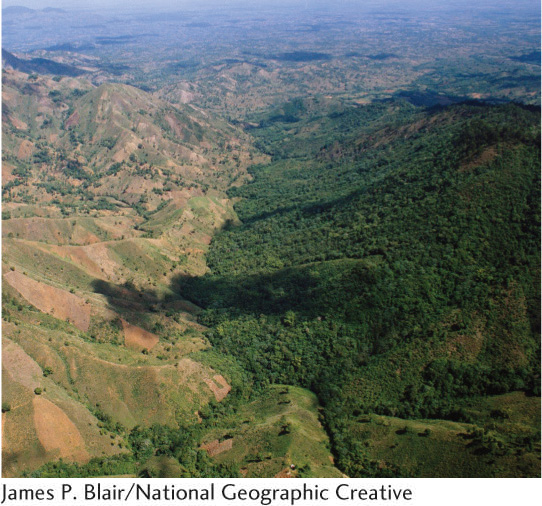
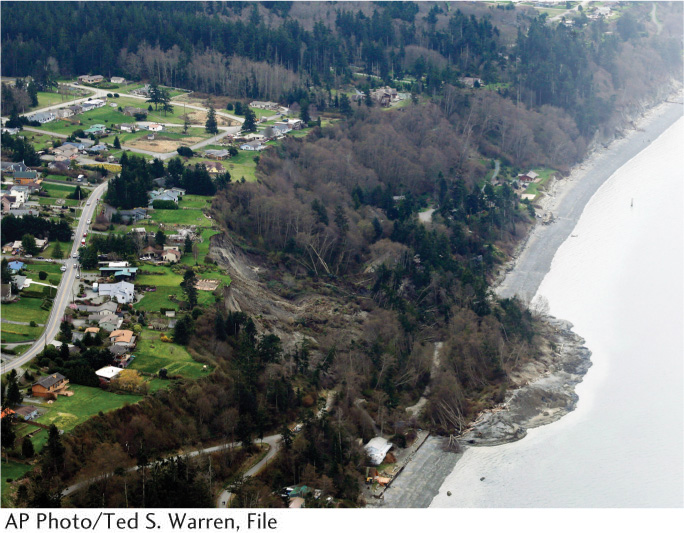
121
The worldwide ecological crisis is not solely a function of overpopulation. A relatively small percentage of the Earth’s population controls much of the industrial technology and consumes a disproportionate percentage of the world’s resources each year. Americans, who make up less than 5 percent of the global population, account for about 25 percent of the natural resources consumed globally each year. New houses built in the United States in 2002 were, on average, 38 percent bigger than those built in 1975, despite a shrinking average household size. If everyone in the world had an average American standard of living, the Earth could support only about 500 million people—only 8 percent of the present population. As the economies of large countries such as India and China continue to surge, the resource consumption of their populations is likely to rise as well because the human desire to consume appears to be limited only by the ability to pay for it. Indeed, in mid-2010, China surpassed the United States to become the world’s largest consumer of energy resources.
ENVIRONMENTAL REFUGEES
Sometimes human adaptive strategies stress the natural environment past the breaking point and previous population densities can no longer be sustained. When that happens, people are forced to migrate. Sudden environmental disasters, such as floods, tornadoes, or forest fires, give rise to a massive human exodus from a destroyed place (Figure 3.27). People who are displaced from their homes due to severe environmental disruption are called environmental refugees.
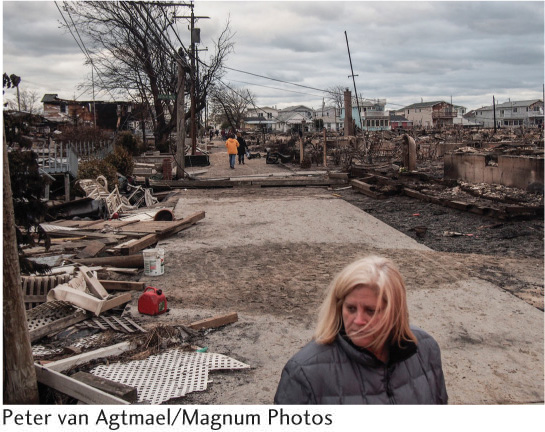
environmental refugees
People who are displaced from their homes due to severe environmental disruption.
122
Environmental Changes in Mexico City. Sometimes environmental changes occur slowly over time. Depletion of the underground water table, for instance, has caused Mexico City to sink, on average, 2.5 inches each year. Some of the larger, heavier buildings in Mexico City, such as the city’s main cathedral, have been sinking even more quickly than that. The Palace of Fine Arts, for instance, has sunk 13 feet in the last century, and its original ground floor has now become the building’s basement.
Mexico City was originally the Aztec capital of Tenochtitlan. Built in the middle of a lake, the Aztecs made use of a series of canals and floating gardens to transport themselves and grow their food. The natural environment was thus minimally altered by its Aztec inhabitants. When the Spaniards conquered Mexico in the sixteenth century, they built Mexico City on top of the ruins of Tenochtitlan and drained the lake in an effort to control flooding. Since then, Mexico City has grown to one of the world’s largest urban areas. Its 21 million inhabitants get their water from an aquifer—a natural underground reservoir. As the water is drained out over time, the underlying layers of soft clay and volcanic silt dry out and collapse unevenly.
Cracked foundations, window frames that are no longer square, and buildings leaning on each other present multiple inconveniences, costs, and hazards (Figure 3.28). According to one Mexico City-based engineer, “When a building tilts more than 1 degree, then I think it becomes very uncomfortable.” He notes that people living in crooked buildings are unable to comfortably lie in bed or even wash dishes, with tap water flowing oddly. “Tables aren’t stable. Liquids don’t look right when they are in big containers. Window panes can break. Doors don’t close right.” Vertigo is a common complaint of people who live and work in tilted structures. Other urban features are also affected. Subway lines and sidewalks need extensive repairs due to sinking, tilting, and buckling. Liquids in drainage canals and pipelines flow uphill.
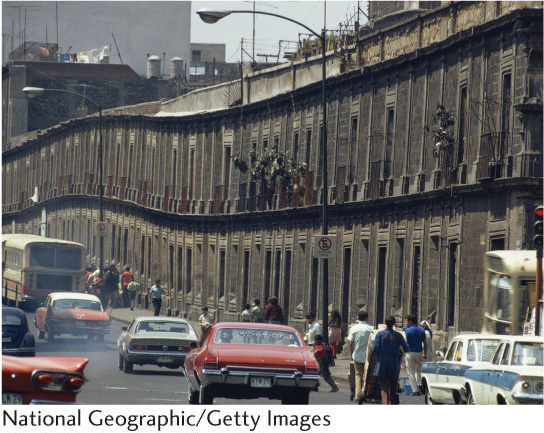
Some structures are in imminent danger of collapse, and 50 buildings have been condemned by the city since 2006, with another 5000 or so known to be unstable. These structures become vulnerable to natural disasters. Because Mexico City is located in an earthquake-prone area, frequent tremors further damage buildings and a larger earthquake could prove disastrous. An earthquake that struck in 1985 caused 800 buildings to collapse and left thousands dead.
123
The adaptive strategy of draining Mexico City’s underground aquifer to provide water for its population has resulted in a slow collapse of the city. At what point will residents begin to migrate to other places because of the hazards posed? Another large earthquake like the one that struck in 1985 might bring about significant population movements out of the damaged city.
A number of environmental catastrophes are closely related to population pressures. Violent hurricanes and sea level rise are associated with global warming; land degradation occurs due to local pressures such as overfarming, contamination, or broader climate change resulting in desertification; and landslides result from deforestation and other effects of human settlement expansion. These are just some of the catastrophes resulting from unsustainable adaptive strategies (Figure 3.29). The Internal Displacement Monitoring Centre estimated that some 32 million people worldwide were forced to flee their homes due to weather-related events alone in 2012. These disasters are more man-made than they are “natural,” and they are often the trigger for large-scale migrations of human populations in search of safer environments.
